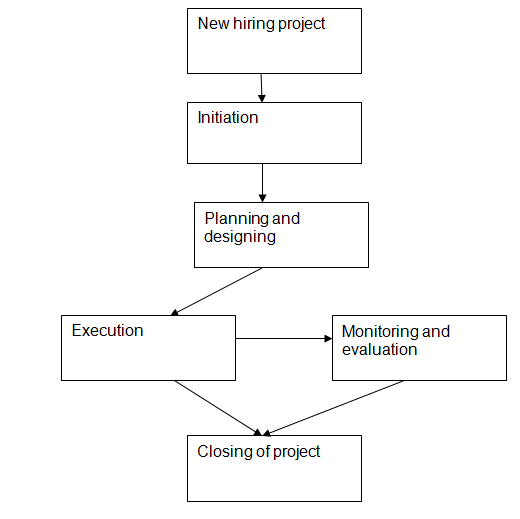The approach, sources, phases, and scope of the project
The new hiring process project will be based on the traditional approach, which has a clear sequence of steps that are important in completion. In order to obtain excellent results, the approach has to be followed closely and any errors detected should be rectified (Kerzner, 2010).
An understanding of the scope of the project could be available from two sources that have been utilized in the development of the proposal (Kerzner, 2010; Lewis, 2011). It will be characterized by the following phases:
- Initiation
- Planning and design
- Implementation
- Monitoring and evaluation
- Closing
It is important to note that the phases will be interrelated. For example, project execution can only take place if initiation, planning and design phases are done successfully.
The scope of the project will be on the premises of the main objective that it will the management will aim at achieving, which will be improving the efficiency with regard to hiring new workers. However, the scope of the project will be conducted in the context of various factors such as budget, resources and schedule that will be adopted (Lewis, 2011).
Requirements, activities and schedule of the project
In order to accomplish a project, it would be important to ensure that all the requirements would be met (Lewis, 2011; Schwalbe, 2013). The proposed project will need the following requirements for successful completion:
- Skilled manpower
- Computer software
- Finances
- Computers
Specifically, an adequate number of computers, with the appropriate software, will be availed to all persons participating in the new process of hiring. Thus, they will be required to have sufficient skills that would be important in using the software. In addition, about $5000USD will be required to execute the project.
Activities are specific actions that are adopted in a project with the aim of supporting outcomes. The following activities will be used:
- Activity1: The management will identify the project leader.
- Activity 2: The leader will initiate the project by planning and adopting a specific that will be followed.
- Activity 3: Human resource personnel will implement the project under the guidance of the project leader.
- Activity4: The leader will monitor and evaluate the executed project to assess its success rate.
- Activity 5: The management will officially close the project on the premises of good success rate.
The project proposal will be implemented within a schedule that will have a specific duration for each activity and/or phase (Kerzner, 2013). The time and phases of the project are covered in the next section of this paper.
Activity duration, sequence of activities, a work breakdown structure, and labor requirements
The table below is used to display the activity and duration that would be taken in the project.
Figure 1. A table showing the activities and duration.
The sequence of events is displayed below.

Figure 2. A series of activities that will be adopted in the project.
The work breakdown structure will be as follows:

Figure 3. The work breakdown structure of the proposed project.
Labor requirements are important in every project because workers execute projects (Kerzner, 2013). The new hiring system will require a minimum of 20 highly qualified personnel who will ensure that the right candidates are hired. Their wages will be determined on the grounds of their academic levels and experience. In addition to their qualifications, they will be educated with regard to the new system.
References
Kerzner, H. R. (2010). Project management best practices: Achieving global excellence (2nd ed.). Hoboken, NJ. John Wiley and Sons.
Kerzner, H. R. (2013). Project management: a systems approach to planning, scheduling, and controlling. John Wiley & Sons.
Lewis, J. P. (2011). Project Planning, Scheduling & Control: A hands-on guide to bringing projects in on time and on budget (5th ed.). New York, NY: McGraw-Hill.
Schwalbe, K. (2013). Information technology project management. Boston, MA: Cengage Learning.